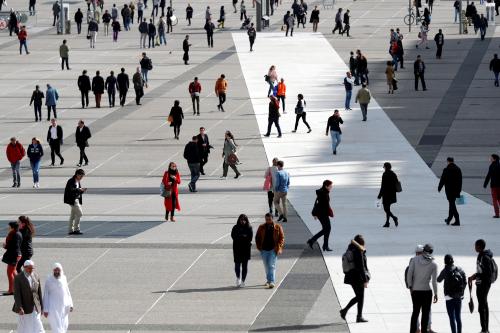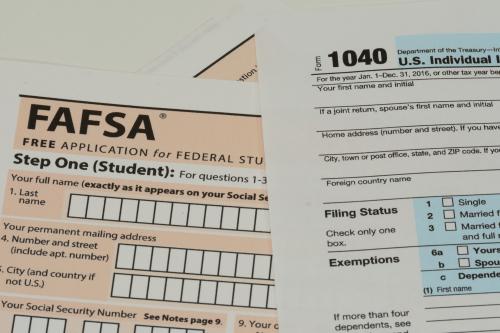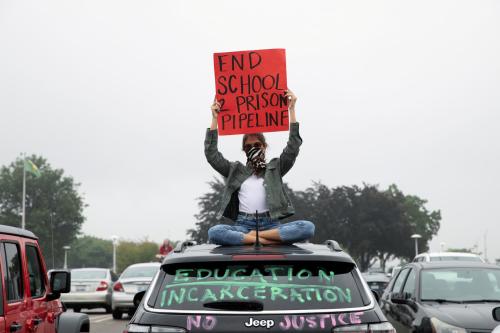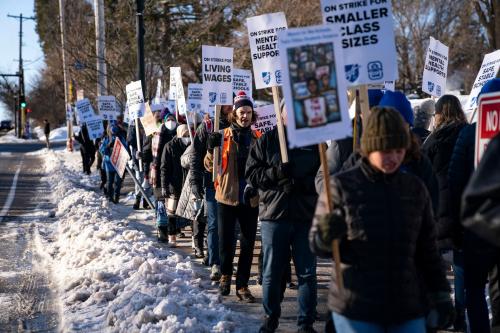If you want more content like this, subscribe to our newsletter.
This week in Class Notes:
- Lifting the minimum wage increases crime.
- Arresting perpetrators of domestic violence lessens future risks.
- Both parents and children choose more academic competition for boys than girls.
- Higher-income men are more likely to work for a parent’s employer, this week’s top chart shows.
- Anya Kamenetz describes a new training program that teaches teens how to help each other out.
- Check out a deep dive into the complexities of Title I education funding by Sarah Reber and Nora Gordon.
- For your calendar: BPEA, federal disability benefits, and re-prioritizing the elementary school social studies curriculum.
Lifting the minimum wage increases crime
How does an increase in the minimum wage affect crime? The answer may surprise you. Using data from the 1998-2016 Uniform Crime Reports, Zachary S. Fone and co-authors find that a higher minimum wage increases rates of property crime among 16-to-24 year olds, who are the group most affected by changes in the legal wage floor. But why? The authors highlight two pathways. First, while wage gains increase the opportunity cost of crime, they also mean that more workers can buy goods such as cellphones – that can be stolen. Second, minimum wage increases are associated with a reduction in employment, which increases crime rates.
Arresting perpetrators of domestic violence lessens future risks
Domestic violence is a major concern for policymakers. Do higher arrest rates make the problem better or worse? Proponents of more arrests argue that a cooling off period, as well as the credible threat of a second arrest, can deter future incidences of domestic violence. While opponents worry that increased arrests can result in backlash from offenders and further escalation of domestic violence. In a recent NBER working paper, Sofia Amaral and co-authors look at emergency calls in a U.K. county. Tracking the outcomes from calls made to emergency services, they find that arrests reduce the possibility of domestic violence by 51% in the following year. To confirm that this reflects a drop in domestic violence rather than lower reporting rates, the authors use a simple threshold model to see if victims lower or raise the threshold of abuse before reporting another domestic violence incident. They find that the reporting thresholds for the next incident are actually lower after an arrest, suggesting that the decline in reporting behavior after an arrest is the result of a real drop in domestic violence rates.
Both parents and children choose more academic competition for boys than girls
How does gender impact the choice of academic competition? Drawing on field experiments with tenth-grade students in 17 Norway schools, Jonas Tungodden and Alexander Willén examine both parent and child preferences for competition, how that affects the gender gap in competitiveness choices, as well as educational and labor market outcomes. First, children and parents of the children at the schools were tested to see how they responded to various competitive and noncompetitive tasks and schemes. The researchers then used administrative data to track educational choices – focusing on selective high schools. The authors find that parents are more likely to choose competition for their sons than their daughters. But they also find even wider gender gaps in the preferences of boys and girls for competition: “parents push more daughters into competition than daughters would choose themselves.” The authors argue that boys and especially girls would benefit in the long run from choosing more academic competition.
Top chart: Economic benefits for nepotism babies
Using the American Community Survey, Matthew Staiger, an economist at Harvard University’s Opportunity Insights, finds that by the age of 30, over a quarter of people have at some point worked at a parent’s place of employment. Children from higher income backgrounds are much more likely to work for a parent’s employer than those from poorer backgrounds. Also, White and Hispanic sons make more use of parental connections than Black sons to secure employment.
 Chart source: The Economist
Chart source: The Economist
Choice opinion: A surprising remedy for teens in mental health crisis
“The more people in a community who have this knowledge, the more likely someone who is hurting will receive an early intervention before their needs become more severe. But there’s also evidence this kind of training can itself promote mental well-being across a population. In preliminary findings from the Johns Hopkins School of Public Health, two-thirds of teens surveyed reported they used the self-care strategies from the training course to deal with their own stress,” writes Anya Kamenetz in The Hechinger Report.
Self promotion: Title I school funding could be better allocated and targeted
“Title I started with a single simple formula in 1965, but it now uses four separate formulas to allocate funds,” Sarah Reber and Nora Gordon write. “It can be difficult to understand why some districts get more funding than others.” In a three-part series written for All4Ed and summarized on our pages, they show how the funding formulas mean that Title I funds are allocated very differently across school districts, and often not in a way that supports the anti-poverty goals of the program. They also show how the Education Finance Incentive Grant program, one of the four formulas used to allocate funds, is poorly designed to improve the progressivity of state spending.
For your calendar: BPEA, federal disability benefits, and re-prioritizing the elementary school social studies curriculum
Brookings Papers on Economic Activity (BPEA) Spring 2023 Conference
Brookings Institution
March 30-31, 2023
Modernizing policy for eligibility for federal disability benefits
American Enterprise Institute
Wednesday, March 15, 2023 2:00 PM – 3:30 PM EDT
The implications for missing infrastructure for elementary social studies
RAND Corporation
Wednesday, March 15, 2022 2:00 PM – 3:00 PM EDT








Commentary
Class Notes: The minimum wage and crime, nepo babies, and more
March 8, 2023